Rigveda is one of the four Vedas. This is the oldest and biggest (it has total 10521 mantras) Vedas. Rest of the Vedas are also inspired by Rigveda, hence Rigveda has the most importance among all the four Vedas. There is no concrete evidence about when it was composed, but some historians speculate differently about it. Western Vedic scholar Max Müller on the Vedas may have composed the Vedas around 1000 to 1200 BC. According to Bharatvanshi Balgangadhar Tilak, the creation of Vedas would have happened around 6000 BC. People who believe in Hinduism consider it beyond time.
Meaning of Rigveda
The word “Rik or ऋक् ” is derived from the root Rich or ऋच् , which means to praise and Veda means knowledge. In Rigveda, the praise of the gods has been told.
इन्द्रमत्यन्धसो विश्वेभिः सोमपर्वभिः । महां अभिष्टिरोजसा ।।
Meaning in English:- God (Indra) protects everything in the sub-atoms of the world in the same way as the Sun, being the largest of all the worlds, gives light to all things.
Composition of Rigveda
There are 12521 Hymns or Mantras in Rigveda. These mantras are tied in 1028 suktos. In this, mainly the description of gods like Agni, Vayu, Indra, Savita, Varuna etc. is found. Some hymns have been fixed for all the deities. Mandals were made by combining suktos in Ringveda and at present there are total 10 mandals available. These Mandalas were also classified into 85 Anuvakas or Adhyayas. Due to having ten mandals in rigveda, it is also called Dashtayi.
The Ringveda is divided in yet another way. According to this division, Ringveda is divided into 8 Ashtakas. A group of hymns is called a class. The total number of this class is 2024. Presently this division process is not in vogue. At present divisional division is the most valid. At the beginning of each hymn of the Rigveda, the name of its author, the sage, the deity worshiped in it and the name of the verse in which it is composed are written.
Pls note :- Apart from these suktos, 11 suktas are known as Valkhilya. Whose place is from Sukta 49 to 59 in the middle of the eighth mandal. The number of mantras in this is 80. Khil means appendices or mantras added later. The main sukta in the eighth circle is 92, while including the Khil suktos, this number becomes 103. Thus, there are total 1028 Suktas in Rigveda.
Mandalas of Rigveda
|
Rigveda’s Mandals |
No of Hyms |
|
Frist Mandal |
191 |
|
Second Mandal |
43 |
|
Third Mandal |
62 |
|
Fourth Mandal |
56 |
|
Fifth Mandal |
87 |
|
Sixth Mandal |
75 |
|
Seventh Mandal |
104 |
|
Eight Mandal |
103 |
|
Ninth Mandal |
114 |
|
Tenth Mandal |
191 |
Frist Mandal
There are a total of 191 Suktas in the first Mandala of Rigveda. The total number of mantras in this is 1976. In these Suktas, fire is considered as a divine substance or fire itself is considered to be the image of God. In the first division of the Rigveda, Ishwariye Upasana, Purushartha, Vidya, Brahmacharya, the excellence of the learned, the duties of the king and the subjects, the qualities of God and the Sun, the qualities of Vayu and Varuna, the various forms and qualities of Prakriti or nature, the religion of man and woman, The importance of Somlata, and its qualities, along with this, the qualities of friend and enemy and the qualities of food etc. have also been widely mentioned. The first verses of the first division of Rigveda are something like this: –
ॐ अग्निमीले पुरोहितं यज्ञस्य देवमृत्विजम्। होतारं रत्नधातमम्॥1॥
(The meaning of this verse is something like this – we worship the fire that is the priest of Yagya, the God, the sage, and the one who invokes the gods and the one who gives the benefits of Yagya to the priests.)
With the help of this verse, sages have worshiped Agni.

Second Mandal
There are a total of 43 Suktas in the second Mandala of Rigveda and this Mandala has the least number of Suktas. The total number of verses in this is 429. The main authors of this division of Rigveda are sage gritasamada and his descendants. The first sukta and mantra of the second mandal of Rigveda are as follows :-
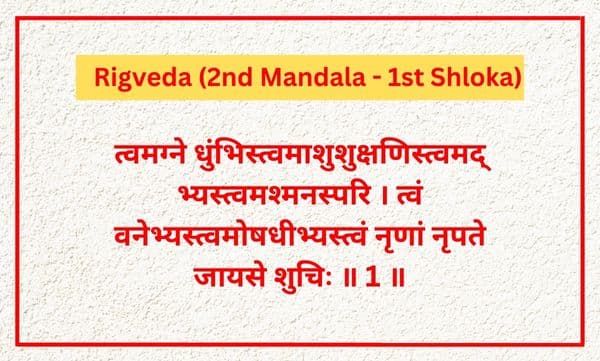
Third Mandal
There are a total of 62 Suktas in the third division of Rigveda and the total number of mantras in it is 617. The chief creator of this circle is Maharishi Valmiki and his descendants. The first mantra of the first sukta of its third division is something like this: –
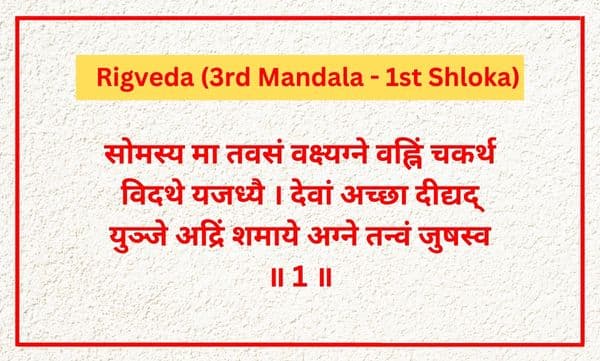
Fourth Mandal
There are a total of 58 Suktas in the fourth division of Rigveda. The total number of mantras in this is 589. The creator of this mandala is sage Vamadev and his descendants. The first sukta and the first mantra of this mandal are as follows: –
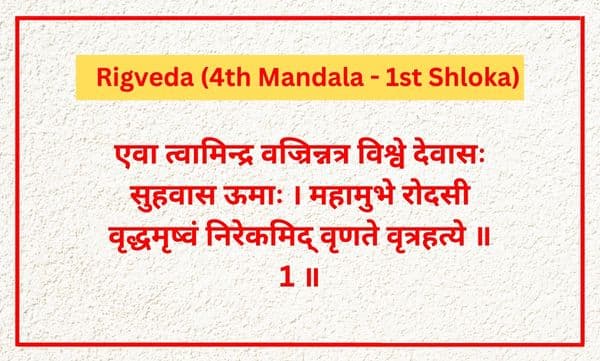
Fifth Mandal
There are a total of 87 Suktas in the fifth division of Rigveda and the total number of mantras in these is 727. The creator of this circle is sage Atri and his descendants. The first hymns of this mandal is as follows: –
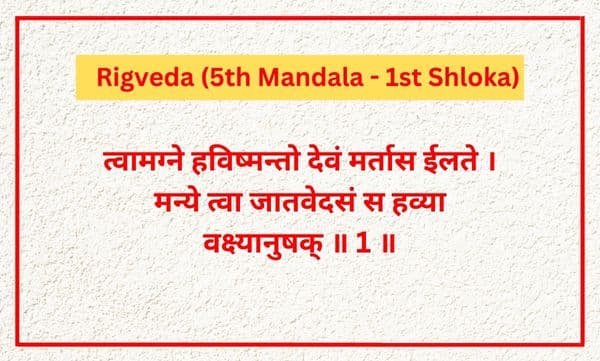
Sixth Mandal
There are a total of 75 Suktas in the sixth Mandala of Rigveda. The number of mantras in this is 765. The creator of this circle is Rishi Bhardwaj and his descendants. This mandal begins with this shloka or mantra:-
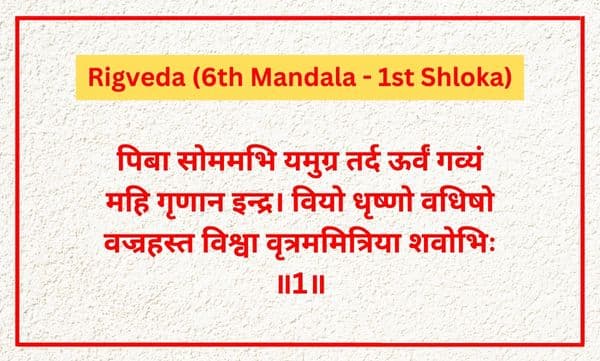
Seventh Mandal
The number of suktos in the seventh division of Rigveda is 104 and the total number of mantras from these is 841. The creator of this mandala is sage Vashistha and his descendants. The first mantra or verse of this mandal is something like this: –
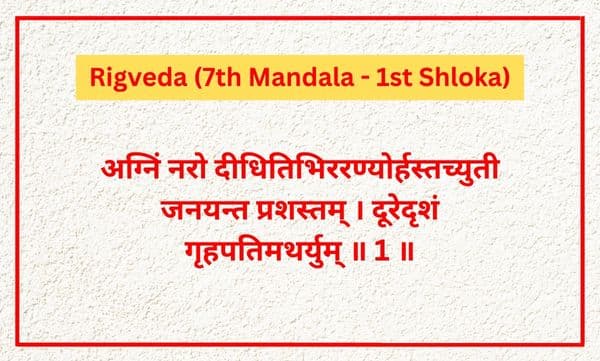
Eight Mandal
There are a total of 103 Suktas in the 8th Mandal of Rigveda and the total number of mantras in these is 1716. The creators of this circle are Rishi Kanva and Rishi Angira and their descendants. This mandal begins with this verse:-
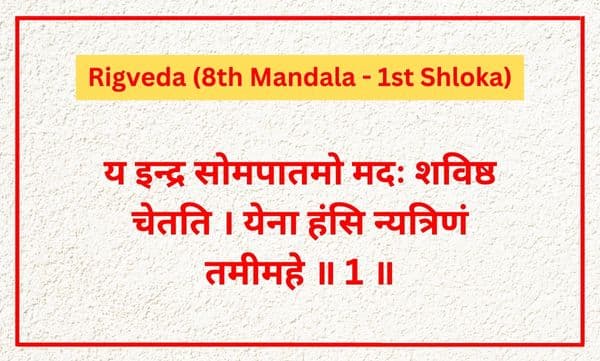
Ninth Mandal
The total number of suktos in the ninth division of Rigveda is 114 and it has a total of 1108 mantras. In this mandal, mainly the deity Som has been told and there are many sages who created it. The first mantra of this mandal is something like this –

Tenth Mandal
According to Mandal order, the last Mandal of Rigveda is the tenth Mandal. The total number of suktos in this is 191, which is equal to the suktos of the first mandal. The total number of mantras in this is 1754. The first and tenth divisions of the Rigveda have the largest number of Suktas. Rishi Vimada, Indra, Sachi and other sages have been considered the creators of this circle.
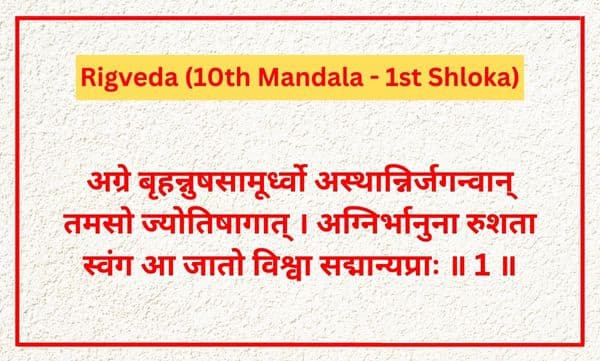
Vansaj Mandal in Rigveda
A special surname has been given from the second mandal to the seventh mandal of Rigveda. They are also addressed by the name of Vansaj Mandal. Some things are common in all these mandals, due to which a special uniformity can be seen in them.
- All Mandals of Vansaj Mandal are seen to be associated with a particular Rishi and his Vansaj.
- Sages Gritsmad, Vishvamitra, Vamadeva, Atri, Bharadvaja and Vashishtha and their descendants are mainly the creators of these mandalas.
- The first mantra of all mandalas is dedicated to Agnidev or Lord Agni. After that comes the Sukta or Hyms of Indra and then the Sukta related to the worship of other gods.
- The sequence of Sukto or Hyms is also the same in all the mandalas of Vansaj Mandal.
Brahmins, Aranyaka and Upnishads of Rigveda
Whenever there is talk of Vedas, their Brahmins, Aranyakas and Upanishads are also discussed along with them. Two Brahmins of Rigveda are found. Aitareya and Kaushitkin or Sankhyan.
Brahmins
There are 40 chapters in the Aitareya Brahmin book. In these, the group of five chapters is called Panchika. Kandikaye has also been imagined at the end of the chapter. According to this Aitareya Brahmana has 40 chapters, 8 panchikas and 285 kandikas.
There are a total of 30 chapters in the Sankhyan Brahmin text of the Rigveda. Each chapter is divided into sections. Whose number is 5 to 17. There are a total of 226 sections in the Sankhyan Brahmana. Sankhyan is a follower of Aitareya from the point of view of Brahmin subject.
Aranyaka
Aranyaka means forest. To understand the secrets of the books, the books which have been studied in the forest are called Aranyak. The Aranyaka texts are an appendix to the Brahmin texts. In Aranyaka, the spiritual explanation of Yagya has been given whereas in Brahmin, the gross form of Yagya has been considered. The description of Aranyaka describes the subject spiritualist, mystic, philosopher and symbolist. Two Aranyakas of the Rigveda are known.
- Aitareya Aranyaka – Aitareya Aranyaka belongs to Shakal branch of Rigveda. It is divided into five parts. Each part is called Aranyak and it has a total of 18 chapters.
- Sankhyan Aranyaka – The Sankhyana is the second Aranyaka of the Rigveda. It is also called Kaushitaki Aranyaka. It has total 15 chapters and 137 sections. Its chapters number 3 to 6 are also called Kaushitaki Upanishad. Its theme is similar to Aitareya Aranyaka.
Upanishads
- Atreya
- Kaushitaki
Main Gods of Rigveda
Many gods have been praised in Rigveda. Vedic sages had discovered them from the middle of nature. In fact, these deities were conceived as a result of the experiences that the Vedic sages had in the midst of the great consciousness of the universe. In all the Vedic Samhitas, the word “God” is nowhere used in the stereotypical form of God. Not only this, this thing has been seen in the context of Panini’s Dharmasutras, Panini’s Ashtadhyayi, Grammar Mahabhashya, Kautilya’s Arthashastra.
In the Vedic codes, only two or four words are found in which the comprehensive form of God has been revealed. In the Vedic deities, the names “Agni, Vayu, Indra, Savita, Vishnu, Varuna, Rudra etc. have come in the context of God. In the Vedic Samhitas, God is described as a Purusha. In about 20 Suktas of all the Vedas, “Purusha” The word has been used. In the Bhagavad Gita also the word “Purushottam” has been used for Lord Shri Krishna. In the “Purusha Sukta” of the Yajurveda Samhita, it has been specially used in the sense of Param Purush or Virat Purush.
However, some scholars also believe that instead of praising the gods in the Vedas, only onegod or supergod is praised. He sees them as different forms of God. In mantras, wherever the relation of deity with creation has been raised, it should be understood that God is the creator in the Supreme. Devgan or Devta completes all the work with the power of the God. Coordinating mantra sentences proves that God is the creator of this world and all power is his original form. The whole world is his comprehensive form. He is the controller of the entire universe.
When Vedas’s knowledge went from the India to other corners of the world, they also did research on it. Western scholars found some common features and qualities in Vedic deities which are as follows: –
- The Vedic gods are closer to the physical objects they represent. This form of his is completely natural.
- The quality of all the gods lies in their benevolent attitude. All the gods appear with their influence for the welfare of the people. All these deities are endowed with divine powers.
- All the gods have been discovered from the middle of nature itself. The divine substance of nature which gave birth to curiosity towards God in the mind of the Vedic sage, the gods were identified from that. All the gods have been established in the form of men.
- One thing is more common in all these deities and that is that the aim of all these deities is human welfare. His behavior is very moderate and by his grace man fulfills his desires.